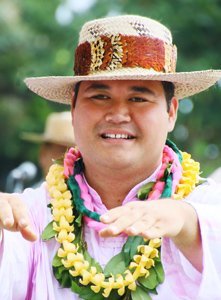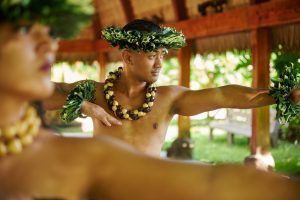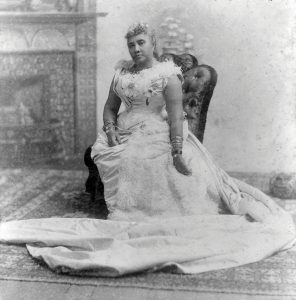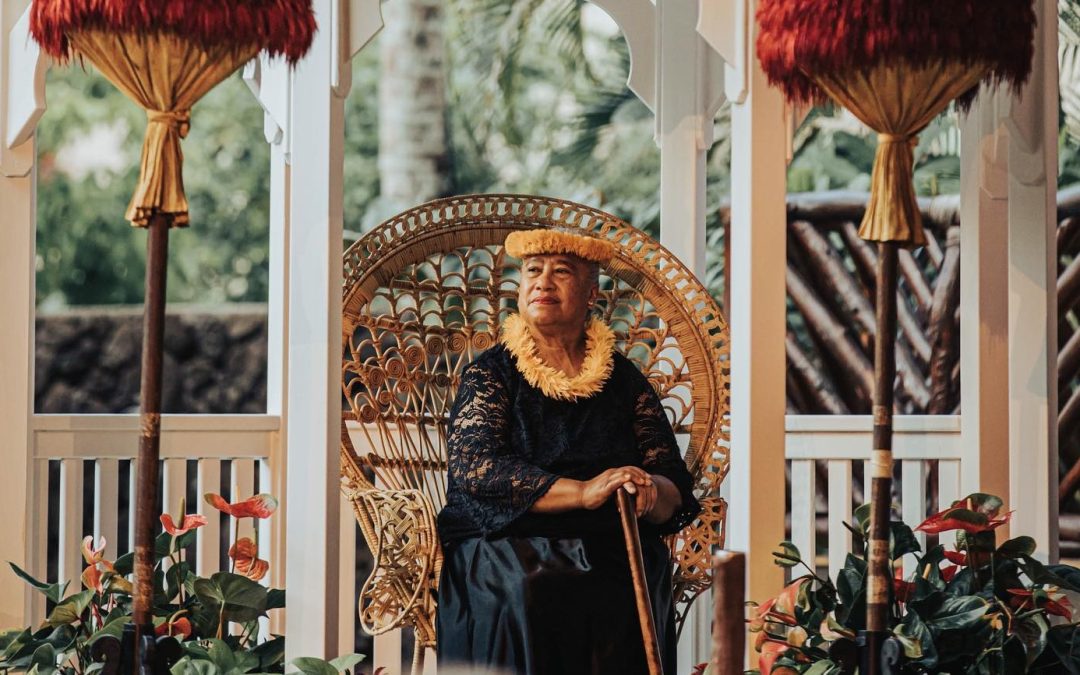‘Onipa‘a: Honoring Hawaiʻi’s Great Queen Lili‘uokalani
At the Polynesian Cultural Center, we pride ourselves on providing a fun-filled adventure of culture and learning, a fully unique experience not to be missed. We love offering a day full of hands-on activities and high energy presentations but, we felt there was something missing. The Center wanted to introduce a new lūʻau show. One that would provide an experience that was distinctly different from any others at the Center, or even on the Island. A moment to breathe and feel the powerful stories of the culture that surrounds you when you visit Hawaiʻi.

Pomaikai Krueger wrote, correographed and produced the beautiful ‘Onipa‘a tribute
For many years, our award-winning lūʻau was intended to be a tribute to the beautiful Hawaiian culture. In 2018 Pomaika’i Krueger, the Center’s Kumu Hula (hula instructor) was tasked with creating an entirely new lūʻau experience for our guests to enjoy. Krueger uniki’d (earned the status of a kumu hula) under Maui’s Kumu Uluwehi Guerrero. He also studied under Maui’s Kumu Iola Balubar, Oahu’s Sonny Ching, and Keith Awai while he was a student-worker in the Center’s Hawaiian Village. Before graduating from BYU– Hawaiʻi in 2009 with a degree in Hawaiian Studies. Krueger taught Hawaiian language and hula at Lahainaluna High School on Maui and had his own halau (hula school) in Wailuku. He also has a halau in Japan and another in Lāʻie.
In 2019 the Center premiered ‘Onipa‘a, which is a tribute to Hawai‘i’s last ruling monarch and only sovereign queen, Lydia Lili‘u Loloku Wewehi Kamaka‘eha, known to her beloved Hawaiian people as Queen Lili‘uokalani. She is considered one of Hawai‘i’s finest composers and we are proud to share the remarkable stories from Her Majesty’s life, told through her own words, songs and original compositions. ‘Onipa‘a, which means steadfast, was the motto of Queen Lili‘uokalani. The spirit of ‘Onipa‘a was integrally woven through every experience of her life.
Krueger said “there was no struggle. Once I decided that it was going to be her story, everything just fell into place.” Most shows go through several drafts, even the Center’s nighttime show HĀ: Breath of Life has gone through many adaptations, but for ‘Onipa‘a little change was made since the initial conception. “The way that it came to me is the way that it is on the stage.”
Becoming the Story

‘Onipa‘a costumers meticulously recreated both period dress and hula outfits for accuracy and stunning presentation
Dressing the Part
There are many reasons why the Center’s Aliʻi Lūʻau is consistently rated one of the best on the island. The dedication to detail and presentation is obvious in every aspect of our lūʻau. The food, meticulously planned and prepared by Executive Chef Felix Tai, is an extraordinary ode to wonders of Hawaiian cuisines and ‘Onipa‘a, the cultural presentation, is entirely unique.
Much emphasis was placed on the fact that ‘Onipa‘a is not a made-up story. We are presenting the Queen’s extraordinary life as told through her own words, with her musical compositions.
To show respect to Queen Lili‘uokalani, copious attention was paid to each detail in the musical and hula presentations as well as the clothing worn by the performers. In preparation for ‘Onipa‘a the costuming team took many research trips to Iolani Palace in Honolulu to study the depictions and clothing of Queen Lili‘uokalani, and the Hawaiian people, that are on display.
The undeniable showstopper in ‘Onipa‘a is the impressive replica of a peacock dress that was worn by Lili‘uokalani’s sister-in-law, Queen Kapi’olani, to the Jubilee of Queen Victoria of England. A beautiful replica of then Princess Lili‘uokalani’s own stunning ensemble worn to the Jubilee is also present during ‘Onipa‘a. It was an elegant black gown with a royal crown flower broach worn on the dress and in her hair she wore her famous butterfly broach whose wings delicately flapped when she walked.

‘Onipa‘a presents beautifully performed hula set to the music and poetry of Queen Lili‘uokalani
Hula Tells a Story
“I feel like hula is a language. When I watch people dance it’s like they’re speaking to me. When I’m teaching my students dance, it’s like their speaking the exact same dialect as me. I understand everything that they’re saying. Without language there would be no way to express ourselves. That is how I feel about hula. It becomes the truest expression of what I’m trying to say. Sometimes I feel like hula is my mother tongue. It’s like the base of my expressions. No matter how many languages you may learn in life, you always have a mother tongue that is the most comfortable, the easiest to express yourself with. That is how I interact with hula.”
– Pomai Krueger
A properly performed hula tells a story. The best performers dance with every part of themselves. Their bodies, faces, and hearts. Our dancers know and feel every song and every story they are sharing. Their authentic experience of what they preform is why they are such powerful storytellers. When they hula, their personal energy is showcased and shared with the audience. This is why Krueger always tells the dancers, “Hula is our acting, we take on the persona of someone else’s story and we become that individual. Getting into that character starts the moment you start getting into costume.”
The dancers for the lūʻau are hand-picked. While being taught the dances for ‘Onipa‘a they are also repetitively drilled in the basics of hula. This creates a strong foundation and makes for a beautiful and natural performance. Krueger explained it best when he said, “the dancers perform beautifully because they feel beautiful.” After months of preparation, every aspect of their costuming and performance feels natural and perfect.
When it was finally time to premier ‘Onipa‘a, Krueger told his performers, “Be present in the moment, you and your hard work deserve that focus and attention. The person whose story you are telling deserves it, and the audience deserves it.”
Although there were those skeptical about changing the lūʻau experience, 3 years later, our lūʻau has reached its highest ever approval rate. One skeptic was even quoted saying “It was the authentic, thoughtfulness of the ‘Onipa‘a presentation that has added so much value to what the Center is offering.”

Remaining ‘Onipa‘a (steadfast) was beautifully represented by Queen Lilioukalani throughout her life (Image courtesy of Ke Ola Magazine)
The Lasting Legacy of a Dignified Queen
Queen Lili‘uokalani was intelligent, compassionate, and dignified. Her legacy continues to benefit her people through the Lili‘uokalani Estate Trust, which provides opportunities for children and help to families.
Our presentation of ‘Onipa‘a seeks to capture and showcase her essence as a dignified, strong leader who put the needs of other people first. Krueger explained “We honor and pay tribute to her not only because of who she was, but because of how she continues to benefit the native community.”
She was an avid reader with a love of learning. She was also a prolific composure of music and poetry, composing over 165 pieces. One of her lifetime achievements was translating all 2,102 lines of the Hawaiian chant of creation, the Kumulipo, into English.
Her story is also an inspiring example of how to meet adversity, how to confront the difficult, unfair, and cruel situations we may encounter in our lives, and face them with strength and dignity. We are proud to honor a woman who was in every way worthy of the title, “Queen.”
Her strength and dignity persists today in the hearts of the Hawaiian people and we are proud to honor her here at the Center.

Bio of Harley M. Charlebois, Blogger for the Polynesian Cultural Center
If I’m not traveling, you’ll usually find me at my favorite tea shop with a pencil and pad, I’m old school like that. Otherwise, you’ll find me eating, shopping, or hanging with my kitten. I am always looking for new foods and experiences to share.


Recent Comments